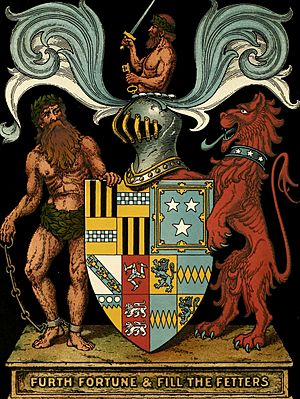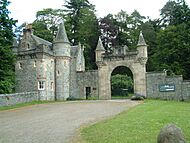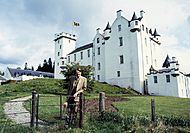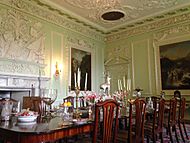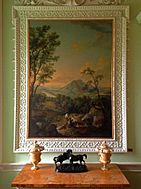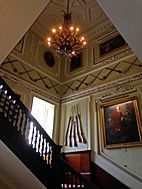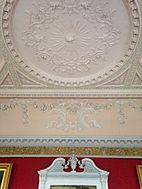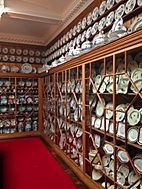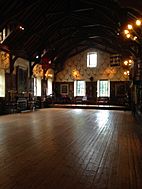Blair Castle facts for kids
Quick facts for kids Blair Castle |
|
|---|---|
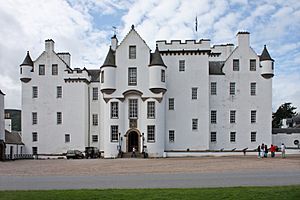
East front of Blair Castle
|
|
|
Listed Building – Category A
|
|
| Designated | 5 October 1971 |
| Reference no. | LB6074 |
|
Inventory of Gardens and Designed Landscapes in Scotland
|
|
| Designated | 1 July 1987 |
| Reference no. | GDL00059 |
| Lua error in Module:Location_map at line 420: attempt to index field 'wikibase' (a nil value). | |
Blair Castle (which means Caisteil Bhlàir in Scottish Gaelic) is a famous castle in Scotland. It stands near the village of Blair Atholl in Perthshire. This castle is the ancient home of the Clan Murray, a Scottish family. It was once the main home of their leader, the Duke of Atholl. Even though the current Duke lives in South Africa, the castle remains a very important place for the family.
Blair Castle is in Glen Garry. It has always been in a key spot on the main road through the Scottish Highlands. This made it very important for controlling travel in the past. The castle is considered a special historic building. Its beautiful gardens are also listed as important national landscapes.
Contents
A Look Back: Castle History
How Blair Castle Began
Blair Castle's story began a very long time ago, around 1269. A man named John I Comyn, Lord of Badenoch started building a tower here. He built it on land that belonged to the Earl of Atholl. The Earl was away on a crusade at the time. When the Earl returned, he was not happy! He complained to King Alexander III. The King agreed with the Earl. The Earl got his land back and made the tower part of his own castle.
Over the years, the castle and lands changed hands many times. Finally, in 1457, King James II gave the land to his half-brother, John Stewart, 1st Earl of Atholl. Later, in 1629, the title of Earl of Atholl was given to John Murray. Since then, the Murray family has owned Blair Castle.
Battles and Sieges at the Castle
Blair Castle has seen many exciting and sometimes dangerous times. In the 1600s, during a period of wars in Britain, the Murray family supported the King. Because of this, Oliver Cromwell's army took over Blair Castle in 1650.
Later, in 1689, a big rebellion started. This was called the first Jacobite rising. The Jacobites wanted to bring back King James to the throne. The Duke of Atholl stayed loyal to the government. However, his castle was held by a Jacobite supporter. The Jacobite leader, Viscount Dundee, even visited the castle.
The Duke's son tried to take the castle back, but he couldn't. Viscount Dundee then came to help the Jacobites at the castle. This led to a very important battle nearby, the Battle of Killiecrankie. The Jacobites won the battle, but Dundee was killed. After the battle, Blair Castle stayed with the Jacobites for a while. It was a key meeting place for them.
The castle was also involved in another big Jacobite rebellion in 1745. Prince Charles Edward Stuart, also known as Bonnie Prince Charlie, and his Jacobite army stayed at Blair Castle twice. But then, government forces took over the castle. The Jacobites tried to get it back and laid siege to the castle in March 1746. The soldiers inside were almost starving! But the Jacobites left to fight the main British army at the Battle of Culloden.
Royal Visits and Modern Times
In 1844, Queen Victoria and her husband, Prince Albert, visited Blair Castle. They even stayed there! After this visit, Queen Victoria gave permission for the Atholl Highlanders to be formed. This is a special private army.
During the First World War, part of Blair Castle was used as a hospital. Many years later, in 1996, the 10th Duke of Atholl made an important decision. He put Blair Castle and most of his lands into a special trust. This helped protect the castle from taxes and kept it under Scottish control. This was important because his heir lived in South Africa.
In 2011, there was a fire at the castle's clock tower. The roof and upper floor of the tower collapsed. But don't worry, the clock tower was fully repaired in 2012.
Exploring the Castle and Gardens
Castle Architecture and Collections
The oldest part of Blair Castle is the six-story Comyn's Tower. It was mostly built in the 1400s. Over the centuries, the castle grew bigger and changed its look many times. In the 1870s, the castle was redesigned to look like a grand Scottish Baronial style building. A large ballroom was also added then.
Since 1936, Blair Castle has been open to visitors. You can explore many rooms inside. These rooms are filled with amazing collections. You can see old weapons, hunting trophies, and souvenirs from the Murray family. There are also beautiful paintings, furniture, and needlework collected over many generations.
The Atholl Highlanders and Gardens
The castle is home to the Atholl Highlanders. This is the Duke of Atholl's own private army. It's famous for being the only legal private army in Europe! The castle and its lands were even featured in a TV show called Conquer the Castle in 2008.
Most of the Dukes of Atholl are buried in the family burial ground. It's next to the ruins of St Bride's Kirk, a very old church, on the castle grounds.
The castle grounds also have beautiful gardens and trees. In 2009, a very tall tree called a Grand Fir was measured here. It was 62.7 meters (about 206 feet) tall! This made it the second-tallest tree in Britain.
Gallery
- Blair castle, exterior and interiors views
-
The 10th Duke outside Blair Castle, by Allan Warren.
-
The Atholl Highlanders parade in front of the castle.
-
The great hall. You can see weapons used at the Battle of Culloden here.
-
A four-poster bed, in the Tapestry room. The tapestries here once belonged to King Charles I.
-
The Ballroom at Blair Castle, designed for the Atholl Highlanders.
See also
 In Spanish: Castillo de Blair para niños
In Spanish: Castillo de Blair para niños


